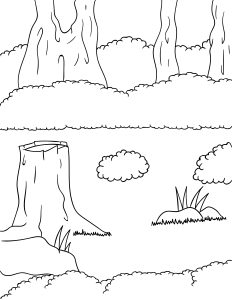 Your Own Picture
Your Own Picture
Sometimes, you don’t want to color in someone else’s picture, sometimes you want to create your own, whether you color it or not. When you want to improve your drawing skills, there are many different resources available. There are various types of lessons, and each one focuses on a particular subject.
Drawing lessons for landscapes cover many different topics, from materials to perspective, as well as how to depict specific elements in your landscapes. Basic landscape drawing lessons cover topics such as trees, rocks, rivers, buildings, clouds, and other features. Whether you want to draw a landscape for personal enjoyment or as part of a project, there’s a lesson available for you.
Starting Out
One of the first things to do with a drawing lesson is to position yourself at a distance from the object you’re trying to portray. Next, think about concepts like proportion and balance. Start with simple familiar objects, such as apples, and move on to more difficult objects.Then, gradually increase the distance from the object, until you are able to draw the object from memory. Once you have mastered the basics of a drawing lesson, you can move onto intermediate tutorials.
Tutorials
You can choose between free tutorials and paid courses. Beginner tutorials will often focus on the basics, such as drawing circles. Intermediate tutorials will cover more advanced techniques, and will include more complex techniques. For beginners, the best way to learn drawing is to take a step-by-step approach and practice until you can follow a tutorial flawlessly. Another important tip is to study your subject and observe the shapes, lines, and values. A smooth, flowing line is often easier to draw than a series of perfectly placed lines. Slowly studying your subject will help you improve your observation skills, and you can even use blind contour drawing as a way to practice working with your hands without looking at your paper. If you can do this for several days at a time, it will pay off. It may sound simple, but it can lead to a more accurate representation.
Online Classes
Free online classes for beginning, intermediate, and advanced artists are also available. These can be taken whenever you feel the need to improve your drawing skills. Another great option is Kline Creative, which offers a variety of tutorial videos on many different subjects. These videos are designed to give a beginner the fundamental drawing skills he or she needs to make a beautiful work of art.
A 90-minute illustration class is a great option for anyone who wants to improve their skills. Video tutorials for beginners are the best way to learn how to draw. You can find many good tutorials by searching for “drawing lessons” in Google. When you use a keyword-specific search, you will see nearly four million results.
If you don’t want to pay a fortune, you can also check out Art and Design Magazines for step-by-step guides. There are a number of different magazines available if you search. Some also offer videos and written guides to help you improve your skills. Digital courses can also be a great resource for beginners. Online courses cover a wide range of topics, from figure drawing to sketching animals and plants. You’ll also learn how to portray realistic lifelike portraits and how to make your images more realistic with light and shadow. You’ll also learn about the proper technique for holding a pencil, so that you can use it effectively. Many drawing classes are free, too! And if you can’t afford to take a class in a traditional studio, consider taking one of the many online classes.
Perspective
The basics of perspective are essential to learning how to draw landscapes. You’ll need to learn about perspective and motion. You’ll also need to know how to apply the Golden Mean Section in your drawings to achieve the right results.Shadows are another key aspect of shading. You can use cross hatching to create a more realistic shadow effect. By using small parallel lines, cross hatching adds more ink and obscures more paper. It also helps you learn to observe form. You can practice shadows and light using different methods, such as shading with a light and dark wash. Once you have learned the fundamentals of shadow, you can move onto other areas of the painting, such as the sky.